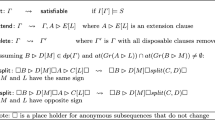Abstract
This paper presents an improvement of Herbrand’s theorem. We propose a method for specifying a sub-universe of the Herbrand universe of a clause set \( {\mathcal{S}} \) for each argument of predicate symbols and function symbols in \( {\mathcal{S}} \). We prove that a clause set \( {\mathcal{S}} \) is unsatisfiable if and only if there is a finite unsatisfiable set of ground instances of clauses of \( {\mathcal{S}} \) that are derived by only instantiating each variable, which appears as an argument of predicate symbols or function symbols, in \( {\mathcal{S}} \) over its corresponding argument's sub-universe of the Herbrand universe of \( {\mathcal{S}} \). Because such sub-universes are usually smaller (sometimes considerably) than the Herbrand universe of \( {\mathcal{S}} \), the number of ground instances may decrease considerably in many cases. We present an algorithm for automatically deriving the sub-universes for arguments in a given clause set, and show the correctness of our improvement. Moreover, we introduce an application of our approach to model generation theorem proving for non-range-restricted problems, show the range-restriction transformation algorithm based on our improvement and provide examples on benchmark problems to demonstrate the power of our approach.
Similar content being viewed by others
References
Herbrand J. Recherches sur la théorie de la démonstration [Dissertation]. University of Paris, 1930.
Gilmore P C. A proof method for quantification theory: Its justification and realization. IBM J. Res. Develop. 1960, pp.28~35.
Manthey R, Bry F. SATCHMO: A theorem prover implemented in Prolog. In Proc. 9th Int. Conf. Automated Deduction, Argonne, Illinois, USA, 1988, pp.415~434.
Bry F, Yahya A. Positive unit hyperresolution tableaux and their application to minimal model generation. J. Automated Reasoning, 2000, 25(1): 35~82.
Stickel M E. Upside-down meta-interpretation of the model elimination theorem-proving procedure for deduction and abduction. J. Automated Reasoning, 1994, 13(2): 189~210.
Geisler T, Panne S, Schutz H. Satchmo: The compiling and functional variants. J. Automated Reasoning, 1997, 18(2): 227~236.
Loveland D W, Reed D W, Wilson D S. SATCHMORE: SATCHMO with RElevancy. J. Automated Reasoning, 1995, 14(2): 325~351.
He L, Chao Y, Simajiri Y et al. \( {\user1{\mathcal{A}}} \)-SATCHMORE: SATCHMORE with availability checking. New Generation Computing, 1998, 16(1): 55~74.
He L. I-SATCHMO: An Improvement of SATCHMO. J. Automated Reasoning, 2001, 27(3): 313~322.
He L, Chao Y, Nakamura T et al. \( {\user1{\mathcal{I}}} \)-SATCHMORE: An improvement of \( {\user1{\mathcal{A}}} \)-SATCHMORE. J. Comput. Sci. & Technol., 2003, 18(2): 181~189.
He L, Chao Y, Itoh H. R-SATCHMO: Refinements on I-SATCHMO. J. Logic and Computation, 2004, 14(2): 117~143.
Loveland D W, Yahya A H. SATCHMOREBID: SATCHMO(RE) with BIDirectional relevancy. New Generation Computing, 2003, 21(3): 175~206.
Schulz S. A comparison of different techniques for grounding near-propositional CNF formulae. In Proc. the 15th FLAIRS, London, 2002, pp.72~76.
Lee S J, Plaisted D A. Eliminating duplication with the hyper-linking strategy. J. Automated Reasoning, 1992, 9(1): 25~42.
Yu Q, Almulla M, Newborn M. Heuristics used by HERBY for semantic tree theorem proving. Ann. Math. Artif. Intell., 1998, 23(3/4): 247~266.
Chang C L, Lee K C T. Symbolic Logic and Mechanical Theorem Proving. New York: Academic Press, 1997.
Loveland D W. Automated Theorem Proving: A Logic Basis. Amsterdam: North-Holland, 1978.
Robinson J A. A machine-oriented logic based on the resolution principle. J. ACM, 1965, 12(1): 23~41.
Sutcliffe G, Suttner C. The TPTP problem library for automated theorem proving. http://www.cs.miami.edu/~tptp/.
The CADE ATP System Competition held at the Third International Joint Conference on Automated Reasoning, Seattle, USA, 2006. http://www.cs.miami.edu/~tptp/CASC/J3/
Schutz H, Geisler T. Efficient model generation through compilation. Information and Computation, 2000, 162(2): 138~157.
Morales J, Carro M, Hermenegildo M. Improving the compilation of Prolog to C using type and determinism information: Preliminary results. In Proc. Colloquium on Implementation of Constraint and Logic Programming Systems (ICLP Associated Workshop), Mumbai, India, December 2003, pp.89~102.
Author information
Authors and Affiliations
Corresponding author
Additional information
This work was supported partially by TOYOAKI Scholarship Foundation, Japan.
Electronic supplementary material
Rights and permissions
About this article
Cite this article
Chao, YY., He, LF., Nakamura, T. et al. An Improvement of Herbrand's Theorem and Its Application to Model Generation Theorem Proving. J Comput Sci Technol 22, 541–553 (2007). https://doi.org/10.1007/s11390-007-9062-2
Received:
Revised:
Published:
Issue Date:
DOI: https://doi.org/10.1007/s11390-007-9062-2




